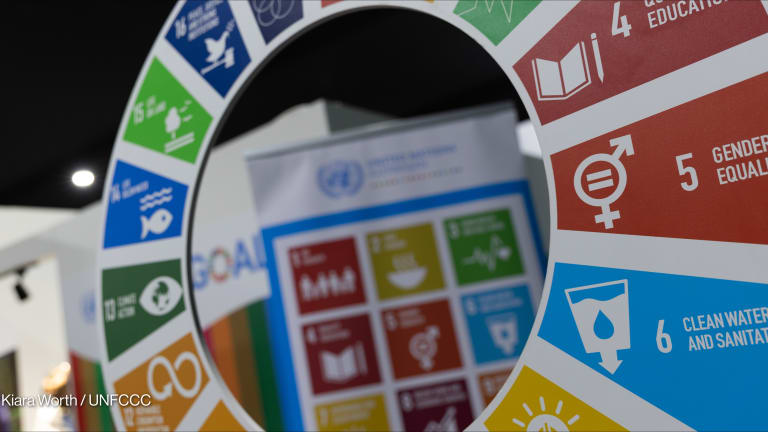8 practical 'how-tos' for the development professional
Knowledge is power, yet the development community has long suffered from a lack of knowledge sharing. A new mobile app hopes to change that for seasoned aid workers, volunteers or those just starting out their careers in international development.
More than 2,000 “how-to” guides across 17 development themes — including in the areas of water, sanitation and hygiene, agriculture, energy and disaster risk reduction — are now available on a mobile phone app. Amid the rise of smartphone usage and greater mobile connectivity, as well as a stronger call than ever for knowledge sharing in development, tech-focused British charity Practical Action has started experimenting with the “Practical Answers” app. Practical Action has been sharing technical know-how on a number of development subjects in more than 15 countries in South Asia, Latin America and Africa for over two decades through their website, where user downloads average 1.5 million annually, according to Sachin Sapkota, digital manager at the NGO. But the app — available in both iOS and Google Play — will act as an alternative channel for knowledge sharing and transfer, he told Devex, a perception that a number of charities have adopted over the past few years. The American Red Cross created an app called “First Aid,” which gives users a step-by-step guide on what to do in case of medical emergencies. Charity Navigator has also developed an app that makes it easier for donors to assess their favorite or potential charities’ performance. Practical Action’s country offices have started using the app, as have several NGOs, such as READ, which establishes resource centers aimed at empowering rural communities in South Asia through education and tech literacy. But Sapkota acknowledged the app currently faces a number of issues, including phone compatibility and language availability. At present, most of the guides and briefs, packaged in PDF format, are in English. He cautioned that while some guides can be used by everyone (rainwater harvesting, for example), others, such as how to build a micro hydro plant, would require the user have a degree of technical expertise. “We also know that the most useful knowledge sharing is locally contextualized. These briefs, by definition, are written with a global audience in mind. So the briefs can always be backed up with more local information accessed through the technical enquiries service, [which] is also available through the app,” he said. Devex downloaded the app to check it out. Here are eight “how-to” guides we think would be useful for development professionals working in different capacities and sectors. 1. How to build and manage a compost heap Development professionals working in agriculture are likely familiar with the different benefits of composting: Apart from saving farmers money, studies have shown that composts provide more nutrients to the soil, help it retain more moisture, and boost some plants’ resistance to diseases, thereby improving produce. Composting also helps in waste management. But it requires more than just piling heaps of waste material. In this 20-page report, Practical Action provides a breakdown of the different materials farmers can use to make compost, and how quick or slow each material decomposes. It also identifies waste that farmers should not include in their composts, factors to consider in making a compost heap, and how to build and manage one. 2. Factors to consider when building disabled-sensitive infrastructure Housing is an important part of post-disaster reconstruction. But often in such circumstances, the needs of people with disabilities are not taken into consideration. This guide provides technical advice on what development professionals need to keep in mind when engaged in post-disaster reconstruction, including the proper positioning of hand rails around the house, the kind of flooring materials to use, and the right size and placement of toilets and wash basins for people using wheelchairs. 3. How to create risk maps Risk or hazard maps help identify which areas are vulnerable to natural disasters such as earthquakes or flooding, as well as possible impact. The app provides development professionals with a quick guide on inputs needed, as well as some examples that would help them determine the vulnerability of different communities on the map. 4. Tips on maximizing the value of cash for work programs Cash for work programs have been gaining ground in development, particularly in emergencies and post-disaster settings. The 15-page guide offers lessons learned from a cash for work program by the Catholic Relief Services in an area in Niger during the Sahel crisis in 2011. 5. Identifying the different distribution models for clean cookstoves Today, 3 billion people still lack access to clean cookstoves, which impacts both health and climate. A number of initiatives have been rolled out over the past five years to help change that, but plenty of barriers still exist, particularly on access. Based on a number of case studies across Africa, Asia and Latin America, the guide identified three types of distribution models that emerged across the selected countries — some not related to cookstoves — their advantages and disadvantages, in which contexts they might be most applicable, some best practices, and recommendations for donors, NGOs and governments. 6. The different tools and approaches in empowering community organizations NGOs and U.N. aid agencies work with a range of community organizations when carrying out their development work. Thus, it’s crucial for development professionals to understand the importance of community organizations and how to empower these organizations to continue development long after they are gone. Practical Action identifies three key principles to guide development professionals in dealing with community organizations as well as the different actions and steps they should take to facilitate community organizations’ independence and empowerment. 7. Tips on waste reduction and management Pressures on natural resources and limited land areas for waste disposal have ushered in the need for solid waste management. The guide provides different options available in waste management, as well as several tips that individuals or management can impose on staff in support of the movement — such as using a bulletin board or email for staff notices and announcements instead of printing individual copies, arranging for vendors to recharge empty cartridges instead of always buying new ones, and putting out a policy for the staff cafeteria to only use reusable utensils. 8. The advantages and disadvantages of different sanitation facilities About 2.5 billion people around the world still don’t have access to a proper toilet, a problem that a number of organizations are focusing their energy on. But the approach cannot be one size fits all. Here, the app provides a 9-page technical brief on the different on-site sanitation systems, their visual layout, as well as their advantages and disadvantages. Sapkota told Devex this is one of the topics that emerged as most popular on their site for the past month. The other two were cashew nut processing and diesel engine maintenance. Devex Professional Membership means access to the latest buzz, innovations, and lifestyle tips for development, health, sustainability and humanitarian professionals like you. Our mission is to do more good for more people. If you think the right information can make a difference, we invite you to join us by making a small investment in Professional Membership.
More than 2,000 “how-to” guides across 17 development themes — including in the areas of water, sanitation and hygiene, agriculture, energy and disaster risk reduction — are now available on a mobile phone app.
Amid the rise of smartphone usage and greater mobile connectivity, as well as a stronger call than ever for knowledge sharing in development, tech-focused British charity Practical Action has started experimenting with the “Practical Answers” app.
Practical Action has been sharing technical know-how on a number of development subjects in more than 15 countries in South Asia, Latin America and Africa for over two decades through their website, where user downloads average 1.5 million annually, according to Sachin Sapkota, digital manager at the NGO.
This story is forDevex Promembers
Unlock this story now with a 15-day free trial of Devex Pro.
With a Devex Pro subscription you'll get access to deeper analysis and exclusive insights from our reporters and analysts.
Start my free trialRequest a group subscription Printing articles to share with others is a breach of our terms and conditions and copyright policy. Please use the sharing options on the left side of the article. Devex Pro members may share up to 10 articles per month using the Pro share tool ( ).
Jenny Lei Ravelo is a Devex Senior Reporter based in Manila. She covers global health, with a particular focus on the World Health Organization, and other development and humanitarian aid trends in Asia Pacific. Prior to Devex, she wrote for ABS-CBN, one of the largest broadcasting networks in the Philippines, and was a copy editor for various international scientific journals. She received her journalism degree from the University of Santo Tomas.








